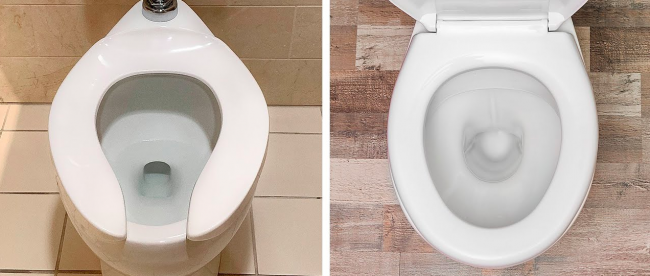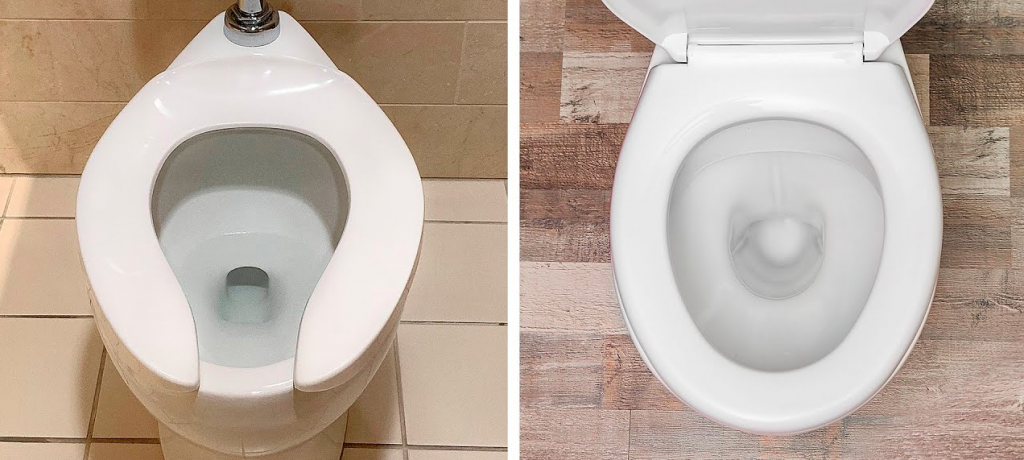Why Public Toilet Seats are U-Shaped

There’s a pretty good chance you’re reading this in the bathroom. Don’t feel bad about it — you’re almost certainly not alone. According to a 2012 survey (of questionable reliability, but let’s not worry about that), approximately 75% of Americans admitted to using their phones on the can. And if we’re being honest, it’s likely that most of the other 25% were lying to the pollsters. As the book says, everyone poops. Most of us also, at least occasionally, also text at the same time.
So, if you’re in the bathroom, take a look at the toilet seat you’re sitting on. (If not, try to imagine a toilet seat. Or maybe go find one. Up to you.) There’s a good chance it is shaped like the letter O — a solid oval which covers the entire bowl. There’s also a very good chance it’s shaped like the letter U; that is, there’s an opening at the front of the bowl, right between your legs, where there’s no seat at all. Just to make it clear, here’s a picture I found from the Internet (while sitting at my desk, I promise):

It’s upside down, but the one on the left is U-shaped. The one on the right is O-shaped. You’ll find the U-shaped ones in public restrooms — at the office, in restaurants, at movie theaters, etc. But if you’re taking care of business at home, you’ll do so with the full coverage provided by the O seat. Both toilets, otherwise, work roughly the same way and serve the same function. So why have two different types of seats?
The short version: it’s safer for women when they wipe.
Toilets and plumbing, before the 1920s, were a chaotic mess: lots of different jurisdictions, each with their own plumbing code. As a result, a plumber in one area, if called to work on a system in an adjacent area, would often be unable to make repairs properly. Leaks and drips and other such problems were common, and when you’re talking about septic lines and sewage, that’s not a mere inconvenience — it’s a health and sanitation issue.
That changed in 1923. A group of plumbing inspectors from Los Angeles a set of standards which, they hoped, would cross jurisdictions. Over time, the group of plumbing inspectors and other plumbing professionals grew to become what is now known as the “International Association of Plumbing and Mechanical Officials,” or IAPMO. And one of the main initiatives of the IAPMO is to draft and promulgate the Uniform Plumbing Code (UPC), a set of rules for plumbers near and far. While the UPC originally focused on pipes and the like, it now addresses everything related to plumbing — including toilet seats.
The U-shaped seat requirement has been around since 1955 but, unfortunately for us, the UPC doesn’t explain why it’s there. (Per Readers’ Digest, it states that “all seats of water closets provided for public use shall be of the open-front type.”) So in 2013, Slate went investigating. They asked Lynne Simnick, then the senior director for code development at IAPMO, to shed some light on the toilet seat gap. Per Simnick, “the open seat was designed to allow women ‘to wipe the perineal area after using the water closet’ without contacting a seat that might be unhygienic.” The front of the toilet rim can be a nasty surface — toilet water may splash on it, people may dribble on it, etc., and who knows when it was last cleaned. The gap in the U-shaped gives the person seated a little extra distance between themselves and the germs. This way, women can wipe themselves without coming into contact with that grossness.
As the UPC isn’t a law, there’s a good chance you’ll find O-shaped seats in public restrooms here or there, and similarly, you’ll often find them in public stalls outside the United States. And of course, you’ll find the O-shaped ones in your house. For at-home use, the gap has little benefit: you’ll probably clean up after yourself. But if you’re going in public, in the U.S. at least, expect to see a seat with some additional space in the front.
Bonus fact: If you are reading this on the can, beware: your phone won’t work if it gets too wet, and there’s a big bowl of water beneath you. And before you say that you’d never be so careless as to deep-six your phone in this way, there’s a good chance you’re overstating your talents. According to a 2011 survey, nearly 20% of smartphone owners have dropped their very expensive device in the toilet.
From the Archives: Why In America, It’s Typically Free to Go Pee: Pay toilets aren’t uncommon throughout the world, but they’re basically unheard of in the United States. Here’s why.
